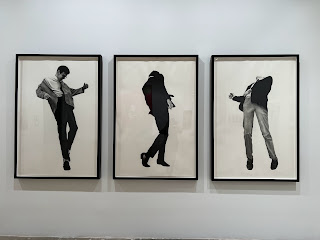Visited the Rubell recently, where I saw a fine Mickalene Thomas in Room 2, from 1997 or so when she first started using patterns in her work, inspired by how Faith Ringgold and Carrie Mae Weems worked from direct experience. Rubell Museum Miami
I didn't understand how Mickalene Thomas' use of pattern, glitter, and brilliant color related so intimately with her childhood until recently. Perhaps that is the unfolding of art over time as bodies of work, affinities, or simply understanding on a deeper level converge to be seen in one's own work. Above is Room 9, screenshot from the Rubell website, featuring headlining artists from my graduate school years in the late 1980s. L to R: Meyer Vaisman, Peter Halley, Haim Steinbach and Allan McCollum on the walls, and Jeff Koon vacuums on the floor. These artists, who came of age with the East Village gallery International with Monument, I perceived conceptually, parsing social critique without understanding how their work engaged décor.
Nearby, Room 13, L to R: Robert Longo Cindy Sherman, Louise Lawler or Sherrie Levine and Richard Prince between. In the 80s, gritty, urban black and found sources looked irreverent, punk--informed by nightclubbing, rooftop parties, and a streak of violence that now comprise an aesthetics of that time when hyper-vigilance first kicks in. Ngai describes the gimmick as "A compromised form bound to an ambivalent judgment (the split between experience and vigilance -Ed.) that its perception spontaneously elicits, the gimmick is an entirely capitalist aesthetic. In this case both: these once-shocking works might be experienced as nostalgiic, though they maintaining their charge for this viewer.
I remembered so well Allan McCullom's proposal of the frame as a surrogate but forgot the embodied lumpiness of their hand-painted forms. The blank black subjects within the frames, commenting on commodity culture as dispensable, are equally aesthetic with the split in consciousness Sianne Ngai proposes is informed by late capital in her 2021 book Theory of the Gimmick (thanks to Mary Jones): "As a judgment, however, the gimmick contains an extra layer of intersubjectivity: it is what we say when we want to demonstrate that we, unike others implicitly invoked or imagined in the same moment, are not buying into what a capitalist device is promising." Jeff Koons' vacuum cleaners' bland reframe join the critique, recasting 1950s domestic labor for public contemplation.
Tishan Hsu and Meyer Vaisman. The Hsu shares the corporate affability of Richard Arstschwager's work while Vaisman's accumulations commune with LA guru John Baldessari.
An early Peter Halley Conduit back wall, two Koons vacuum cleaners
Early David Salle, who, similar to Meyer Vaisman and John Baldessari, treat the photograph as found image. A suprisingly raw painting unloading the contents of his brain, it feels, recalling the first time I saw a Salle in the Count Panza de Biumo Collection at MoCA Contemporary in 1985. The guttural, deskilled, slashes of brilliant tube color stayed with me as an alternative to rules-bound decoruml. Apparently I was not the only person seduced. What makes this painting wonderful is the empty liquid ground in contrast to scrubbed and drawn paint.
Men in the Cities! Classic Robert Longo drawings that use the method he continues today in vast, operatic commentaries on climate change and politics. Longo joined Salle, Julian Schnabel, and Eric Fischl as the Four Brushmen of the Apocalypse circa 1987. Longo later directed the film Johnny Mmemonic, and shows with Pace.
Richard Prince, working with advertising images and here the NYT, working for and against nostalgia and fair use, so the work never dates.
The objects at Rubell clarify struggles in consciousness, the curse of self-awareness that implicitly critiques its work. This relates to doubt as pertains to Guston or Cezanne but equally a doubt special to late capitalism, in which everything can be seen as a gimmick. This in turn engenders a traumatic split as explained by Jungian analyst Donad Kalsched in a 2006 interview with Daniela F. Sieff: "The initial moment of psychological dissociation is a miraculous moment in that ... defensive splitting saves the child’s psychological essence in an encapsulated state, but it is also a tragic moment because with this splitting the child steps out of the reality and vivacity of his or her life. It is a moment when the child separates from experience, goes into trance, and when the child’s capacity for genuine and trusting human relationships starts to disintegrate." All of these factors seem to be in play in the art of these Rubell Period Rooms.









